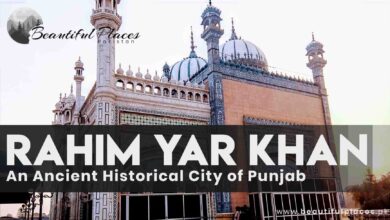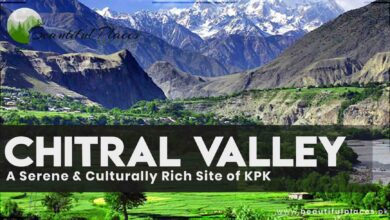Charsadda
The historical city of Charsadda is in the northeast of Peshawar at a distance of 28km. Its old name was Pushkalavati. Pushkalavati is mentioned in the sacred Ramayan- a book of Hindus. Pushkalavati was the capital of the Gandara civilization from the 6th century B.C to the 2nd century A.D.
Pushkalavati Museum in Charsadda will give you awareness of this historic city. A Ghani Dheri Museum related to the famous poet, artist, and philosopher Abdul Ghani Khan is in the Ghani Dheri town at a distance of 15 minutes drive from Charsadda.

Details of Charsadda – Khyber Pakhtunkhwa
| Aspect | Details |
|---|---|
| Country | Pakistan |
| Province | Khyber Pakhtunkhwa (KP) |
| Location | Northern Khyber Pakhtunkhwa, bordering Nowshera and Peshawar districts |
| Area | 996 square kilometers (385 square miles) |
| Population | Approximately 1.5 million |
| Official Language | Urdu, Pashto |
| Other Languages | Hindko, Punjabi |
| Climate | Hot semi-arid with hot summers and mild winters |
| Famous Landmarks | Alexander’s Fort (Razmak), Dargai Heights, Umarzai Reservoir |
| Historical Significance | Charsadda has a rich historical background and was once a major center of the Gandhara civilization. It has witnessed the influence of various empires, including Mauryan, Kushan, and Indo-Greek. The region has archaeological sites showcasing the ancient Buddhist heritage. |
| Cultural Heritage | Charsadda is known for its Pashtun culture and traditions, including traditional music, dance forms like Attan, Pashto poetry, and hospitality. The region also has a rich tradition of handicrafts, including embroidery and weaving. |
| Educational Institutions | Abdul Wali Khan University Mardan (Charsadda Campus), University of Engineering and Technology Peshawar (Charsadda Campus), and several colleges and schools |
| Transportation | Charsadda is well-connected through a road network, with Peshawar International Airport being the nearest major airport. The district has a railway station in Tangi, which provides access to the national rail network. |
| Major Industries | Agriculture (especially sugarcane, wheat, and tobacco), small-scale industries, trade, services |
| Cuisine | Charsadda offers traditional Pashtun cuisine, including Chapli kebab, Lamb karahi, Kabuli pulao, and various dairy-based desserts. |
| Festivals | Eid-ul-Fitr, Eid-ul-Adha, Pashto cultural festivals like Khattak Festival, and local events celebrating harvest seasons and traditional customs |
| Sports | Cricket, football, kabaddi, traditional wrestling (Pehlwani) |
| Historical Sites | Takht-i-Bahi (UNESCO World Heritage Site), Shahbaz Garhi, Sahr-i-Bahlol, Jandala Stupa, Ashoka Rock Edicts, Charsadda Museum |
| Parks and Gardens | Bala Hisar Garden, Bagh-e-Naran, Balahisar Park, Tehmas Khan Cricket Stadium |
| Art and Literature | Charsadda has a rich tradition of Pashto poetry, storytelling, and folk music. The region has produced renowned poets, writers, and artists. |
| Shopping | Traditional bazaars offering a variety of handicrafts, textiles, and agricultural produce. |
| Religious Sites | There are several historic mosques, shrines, and temples in Charsadda, including Shahbaz Ghari Shrine, Kalinger Shrine, and Katlang Mosque. |
| Museums | Charsadda Museum, which houses artifacts and relics from the Gandhara civilization and other archaeological finds. |
| Performing Arts | Charsadda hosts traditional Pashto music and dance performances during festivals and cultural events. |
| Tourism | Charsadda is a popular destination for history and archaeology enthusiasts due to its ancient Buddhist sites and archaeological. |
History of Charsadda
Charsadda is an ancient district with a rich history that dates back thousands of years. It is believed to have been inhabited since the prehistoric times and has witnessed the rise and fall of various empires and civilizations. The district has been a part of the Gandhara civilization, which was renowned for its art and architecture. It was also a significant center along the ancient Silk Road, connecting different regions and facilitating trade and cultural exchanges.
Culture and Traditions
Charsadda has a vibrant Pashtun culture and is known for its hospitality, bravery, and traditional values. The people of Charsadda, predominantly Pashtuns, adhere to the Pashtunwali code, which emphasizes concepts such as honor, hospitality, and loyalty. Pashto is the primary language spoken in the district, and Pashtun traditions and customs are deeply rooted in the local lifestyle. Traditional music, dance forms like Attan, and Pashto poetry are celebrated and performed during social gatherings and festivals.
Famous Tourist Spots in Charsadda
- Takht-i-Bahi: Takht-i-Bahi is a UNESCO World Heritage Site and one of the most famous tourist attractions in Charsadda. It is an ancient Buddhist monastery complex dating back to the 1st century BCE. The site contains well-preserved stupas, monastic cells, and a main assembly hall, providing insights into the Gandhara civilization.
- Bala Hisar Fort: Bala Hisar Fort is a historic fortress located in the heart of Charsadda. It was originally built by the Persians and later reconstructed by various rulers throughout history. The fort offers panoramic views of the surrounding areas and serves as a reminder of Charsadda’s historical significance.
- Rajgaarh Fort: Rajgaarh Fort is another notable historical site in Charsadda. It is believed to have been constructed during the Kushan Empire and was later used by various dynasties. The fort is situated atop a hill and offers scenic views of the surrounding landscape.
- Gor Gathri: Gor Gathri is an archaeological site located near the village of Shin Gathri in Charsadda. It is known for its ancient stupa and Buddhist remains, showcasing the religious and cultural significance of the region during the Gandhara period.
- Sheikh Baba Fort: Sheikh Baba Fort, also known as Umar Baba Fort, is a historic fort situated in the outskirts of Charsadda. It was built during the reign of Emperor Sher Shah Suri and served as a strategic stronghold in the region.
- Wazir Bagh: Wazir Bagh is a beautiful garden located in Charsadda. It is known for its lush greenery, well-manicured lawns, and serene atmosphere, making it a popular spot for picnics and leisurely walks.
Administrative Divisions
Within Charsadda district, you can find several subdivisions and towns. These include Tangi, Shabqadar, and Charsadda city, each with its unique character and charm. Local governance plays a vital role in the development of these areas.
Challenges and Opportunities
Charsadda, like many regions, faces socio-economic challenges such as poverty, unemployment, and healthcare disparities. Nevertheless, with its fertile land, industrious population, and rich history, there are numerous opportunities for growth and development. The district’s proximity to major urban centers like Peshawar offers prospects for trade and commerce.
Schools in Charsadda
- Government High School
- Abdul Wali Khan University Model School and College
- Army Public School and College
- Peshawar Model School, Charsadda Campus
- The Educators, Charsadda Campus
Colleges and Universities in Charsadda
- Abdul Wali Khan University
- Government Postgraduate College
- Government Girls Degree College
- Cadet College, Charsadda
- Government College of Technology
Hospitals in Charsadda
- District Headquarters Hospital
- Khyber Teaching Hospital
- Khalifa Gul Nawaz Teaching Hospital
Restaurants in Charsadda
- Shinwari Restaurant
- Khan Baba Restaurant
- Rahat Bakers and Sweets
- Quetta Tikka House
- Dera Restaurant
FAQs
What is the historical significance of Charsadda District?
Charsadda has a rich history dating back to ancient civilizations. It was once known as “Pushkalavati” and was a prominent center of the Gandhara civilization. Many Buddhist relics and artifacts have been discovered here.
What is the population of Charsadda District?
As of the latest available data, the population of Charsadda District is approximately 1.5 million people. However, please note that population figures may have changed since then.
What are the major languages spoken in Charsadda?
Pashto is the primary language spoken in Charsadda District. However, Urdu is also widely understood and spoken, especially in urban areas.
Can you tell me about Charsadda’s geographical location?
Charsadda is located in the northwestern region of Khyber Pakhtunkhwa, Pakistan. It is situated on the west bank of the Kabul River and is bordered by Peshawar to the south and the border with Afghanistan to the west.
Are there any notable educational institutions in Charsadda District?
Yes, Charsadda is home to several educational institutions, including Abdul Wali Khan University, Government College Charsadda, and a number of schools and colleges.
What are the major crops and agricultural products in Charsadda?
Charsadda is known for its fertile agricultural land. The major crops grown here include wheat, sugarcane, tobacco, and various fruits, especially citrus fruits.
Is Charsadda a safe place to visit for tourists?
Charsadda has experienced security challenges in the past, but the situation has improved in recent years. It’s always advisable to check the current travel advisories and consult local authorities before planning a visit.
What is the significance of Charsadda in contemporary Pakistan?
Charsadda plays a role in Pakistan’s agricultural and industrial sectors. It’s also known for its historical and archaeological sites, contributing to the country’s cultural heritage.
Can you tell me about any famous personalities from Charsadda District?
Charsadda has produced many notable individuals, including the late Bacha Khan, a prominent political and social leader who played a vital role in the independence movement of the Indian subcontinent.
What are the main industries in Charsadda?
Charsadda is known for its small-scale industries, including agriculture-based enterprises, handwoven carpets, and cottage industries. Agriculture remains the primary economic activity in the district.
Wind Up Lines
District Charsadda is not just a geographical entity; it’s a living testament to the history, culture, and potential of the people in Khyber Pakhtunkhwa. While it may have its challenges, it also harbors countless opportunities for a brighter future. As Charsadda continues to evolve and thrive, it remains an essential part of the province’s vibrant tapestry.
In summary, Charsadda district offers a captivating blend of heritage and modernity, providing a unique perspective on life in Khyber Pakhtunkhwa. With the right investments and focused efforts, it has the potential to shine even brighter on the map of Pakistan’s progress.



